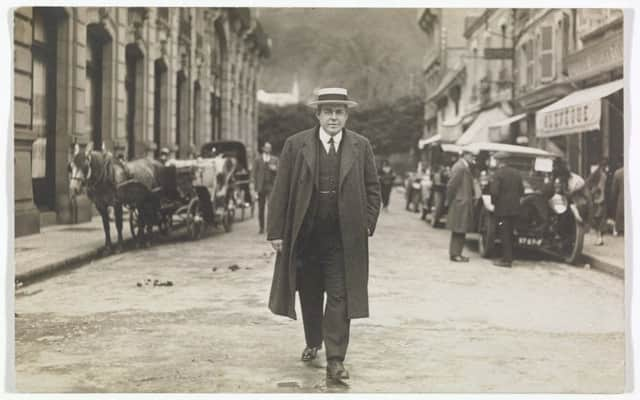Traditional celtic tales and ancient Bible manuscripts to mark Easter


To the County of Antrim famed in story and song.
Its hills and its valleys, its glens and its streams,
Its mountains and rivers exceed all our dreams.’
The rousing opening of today’s page comes from
Ballymena-reader, poet and local historian James McIlhatton.
His poem about County Antrim accompanied his recent letter about the oft-recounted Conal Cearnach “from that ancient capital of Dalriada” wrote Mr McIlhatton.
Advertisement
Hide AdAdvertisement
Hide AdHailing from our distant, Celtic past - and mentioned on this page on several occasions regarding Dunseverick Castle - Conal Cearnach was “with Joseph of Arimithea when Christ’s body was laid in the sepulchre” Mr McIlhatton’s letter continued.
There are more than a few references in local history circles to Conal Cearnach’s journey from Dunseverick to Jerusalem at the time of Christ’s crucifixion, most of them highlighting the story’s faint traces back to, and even beyond, mythology.
More about Conal in a moment, but staying with the Easter seasonal theme, it was reported on Wednesday that some of the oldest surviving bible manuscripts, including St Paul’s Letter to the Corinthians recounting the death of Jesus Christ, are on display in Dublin’s Chester Beatty library.
Found on the banks of the Nile in the 1920s, the ancient texts contain parts of the Old and New Testament dating from 200 to 400 AD.
Advertisement
Hide AdAdvertisement
Hide AdThe manuscripts, written in Greek on papyri in Egypt, were bought by Sir Alfred Chester Beatty in 1931.
Chester Beatty, an immensely wealthy mining magnate and ardent antiquities collector, was born in New York in 1875 of Irish, Scots and English descent.
The section of the letter from St Paul to the Corinthians, recounting Jesus Christ’s death, burial and resurrection, is particularly timely for visitors to view over the Easter period. (Though the library is closed today and Monday, it is open to the public tomorrow and Sunday.)
Sir Alfred, a distinguished book-collector as well as an international mining entrepreneur, was a personal friend of eminent statesmen like President Hoover and Sir Winston Churchill.
Advertisement
Hide AdAdvertisement
Hide AdDuring WWII he made an important contribution to the Allied war effort, and was a major benefactor of hospitals and medical research as well as being an enlightened employer.
His mining enterprises made him a millionaire by the age of 30, allowing him build up vast geology and philately collections, and later to amass a unique collection of old Eastern paintings and Chinese snuff bottles, many of the latter carved from gemstones.
He also started buying books and manuscripts and when he left America for Britain in 1911 he was already a serious and discerning collector.
A widower with two young children, he remarried in 1912 when he and his new wife, Edith Dunn, honeymooned in Egypt.
Advertisement
Hide AdAdvertisement
Hide AdThey had homes in London and Cairo, where Sir Alfred’s interest in Islamic culture was intensified.
His wife also collected decorative art objects and Impressionist paintings.
Sir Alfred’s book and manuscript collection grew bigger as he added illuminated copies of the Qur’an, and Mughal, Turkish and Persian manuscripts.
He enhanced his Christian antiquities with acquisitions of Coptic, Syriac and Greek manuscripts.
Advertisement
Hide AdAdvertisement
Hide AdAlmost by chance in the late 1920s he acquired some papyrus texts which proved to contain exceptionally important biblical, especially New Testament, material, like St Paul’s Letter to the Corinthians currently on view in Dublin.
Chester Beatty became a naturalised British subject in 1933. He moved to Ireland where he became the country’s first honorary citizen in 1957, having set up his library in 1950 in Ballsbridge, Dublin.
With his library left in trust for the benefit of the public, when Sir Alfred died in 1968 he was the first private citizen accorded a state funeral in Ireland.
Now counted as one of Ireland’s national cultural institutions, and one of the best libraries of its kind in the world, it is located in Dublin Castle and full details are on www.cbl.ie
Advertisement
Hide AdAdvertisement
Hide AdI’m sure many News Letter readers will be interested to see those historic, papyri manuscripts, particularly St Paul’s Letter to the Corinthians and the Easter story.
The image here today is courtesy of the Trustees of The Chester Beatty Library, Dublin.
“Of grand ancient history there’s stories galore,
Of the Danes and the Vikings, the Normans and more.
Who came to our land to plunder and rob,
And fight with the Ulstermen on their own shore.”
Not from the News Testament, but that’s another verse from James McIlhatton’s poem about County Antrim that accompanied his letter about Conal Cearnach “from ancient Dalriada who reputedly was with Joseph of Arimithea when Christ’s body was laid in the sepulchre.”
The Celtic tale that James referred to is mentioned in countless ancient Irish manuscripts.
Advertisement
Hide AdAdvertisement
Hide AdConal Cearnach “wrestled with one of Rome’s most powerful gladiators in the presence of Emperor Caesar Augustus” James explained.
“After defeating his opponent…Conal Cearnach travelled with a regiment of Roman soldiers to many middle-Eastern towns, arriving in Jerusalem on the morning of the crucifixion.”
James McIlhatton’s letter continued “He was reputed to have been present as Simon the Cyrene carried the cross and was with Joseph of Arimithea when Christ’s body was laid in the sepulchre.”
Conal Cearnach returned to Dunseverick with an account that was oft’ repeated throughout Celtic mythology, and is still told here by local historians.
Happy Easter from Roamer.